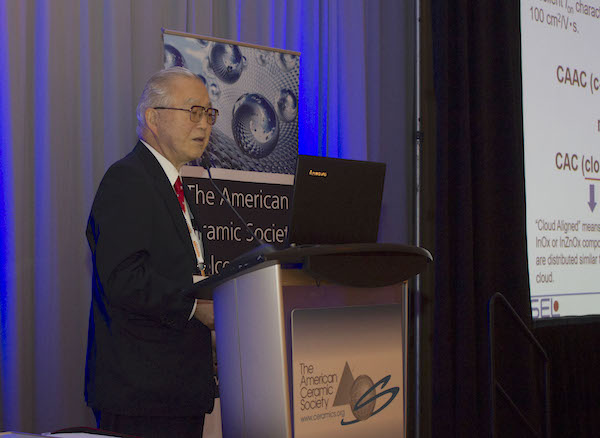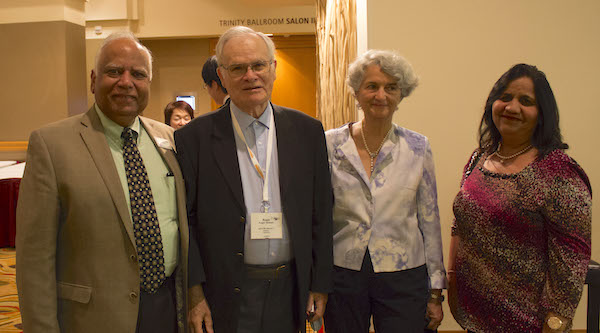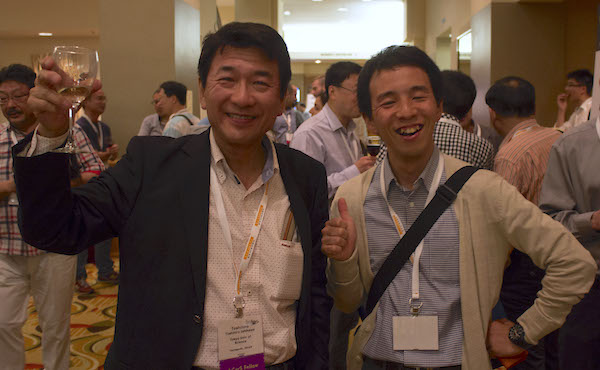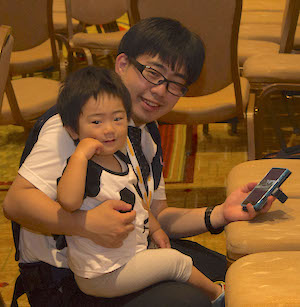
[image above] Semiconductor Energy Laboratory (Japan) brought prototype display devices enabled by semiconducting oxide material. SEL founder and president, Shunpei Yamazaki, is in the background (white shirt with red tie). Credit: ACerS
About 425 ceramic engineers, scientists, and students are in Toronto this week to attend the 9th International Conference on High Temperature Ceramic Matrix Composites (HTCMC) and the Global Forum on Advanced Materials and Technologies for Sustainable Development (GFMAT). This truly international conference brings together attendees from 24 countries, and 58 students are here.
The conference opened today with a morning plenary session and will continue through Friday.
Ceramic matrix composite technology has come a long way since the first edition of this conference in 1993 in Bordeaux, France.
Doesn’t it seem like we’ve been hearing about the potential of CMC’s for aerospace for decades? It’s exciting to see that dream on the verge of realization with General Electric’s LEAP engine. The new engine—and its CMC parts—will go into service in fall 2016. GE plans to add more CMC parts in future engine designs, according to plenary speaker Katherine Stevens, who is GE’s general manager, materials and process engineering.
An interesting talk opened the plenary session. If you’ve used a flash drive, Shunpei Yamazaki, the lead-off plenary speaker at HTCMC-GFMAT, has touched your life. That’s because he invented flash memory in the 1970s. He’s been a prolific inventor—over 6,000 patents bear his name. Much of that creativity occurred at the company he founded in 1980, Semiconductor Energy Laboratory (SEL) in Japan, where he serves as president. SEL is a materials company that hands off its new materials to device makers, such as Sharp, so his talk focused more on materials than devices, although device applications were clearly in mind.
Yamazaki described the discovery of semiconducting indium gallium zinc oxide for display applications. Get ready, because a revolution in display, and therefore devices, is on its way thanks to this material. Yamazaki brought demonstration prototype devices with him—a foldable display device and a smartphone display that’s responsive to changing light conditions, such as when you exit a building and cannot read a display flooded by sunlight. The foldable display amounted to a tablet that could be folded and dropped in a purse or coat pocket.
The conference includes several special sessions, including a symposium in honor of Roger Naslain. Naslain, professor emeritus at the University of Bordeaux in France and ACerS Distinguished Life Member, founded the HTCMC series in 1993. Asked if he was surprised by the longevity of the conference, he said, “No, because I knew there was nothing else like it for these materials.”
Chances are the conference will continue for quite some time, based on the number of young scientists. Many are participating in the Young Professionals Forum. Besides sharing their research results, they have the opportunity to learn about research funding in academia and industry. In addition, a “survival skills” seminar sponsored by St. Gobain will occur today.
YPF co-organizer Surojit Gupta successfully secured funding to provide travel stipend for eight students. Those students will be sharing their experiences of the conference via this blog. See, for example, the first student post from Matt Fuka from the University of North Dakota.
Stay tuned for more as the week unfolds. Meanwhile, enjoy the first images from the event.

Shunpei Yamazaki, founder and president of Semiconductor Energy Laboratory in Japan, was the first plenary speaker at HTCMC-GFMAT. Credit: ACerS

Reconnecting with friends and colleagues at Sunday night’s welcome reception. Credit: ACerS

Roger Naslain (second from left) founded the HTCMC series in 1993. He is pictured with this year’s general chair and ACerS president, Mrityunjay Singh; his wife, Dominique Naslain; and Singh’s wife, Gita Singh. Credit: ACerS

Happy to be in Toronto at HTCMC-GFMAT! Credit: ACerS

Sanjay Mathur (right) inspects the folding tablet. Mathur organized the GFMAT program. Credit: ACerS

The future looks bright! Credit: ACerS
